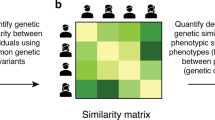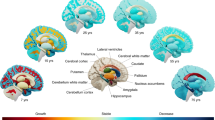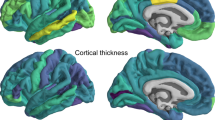Abstract
Sensitivity to external demands is essential for adaptation to dynamic environments, but comes at the cost of increased risk of adverse outcomes when facing poor environmental conditions. Here, we apply a novel methodology to perform genome-wide association analysis of mean and variance in ten key brain features (accumbens, amygdala, caudate, hippocampus, pallidum, putamen, thalamus, intracranial volume, cortical surface area, and cortical thickness), integrating genetic and neuroanatomical data from a large lifespan sample (n = 25,575 individuals; 8–89 years, mean age 51.9 years). We identify genetic loci associated with phenotypic variability in thalamus volume and cortical thickness. The variance-controlling loci involved genes with a documented role in brain and mental health and were not associated with the mean anatomical volumes. This proof-of-principle of the hypothesis of a genetic regulation of brain volume variability contributes to establishing the genetic basis of phenotypic variance (i.e., heritability), allows identifying different degrees of brain robustness across individuals, and opens new research avenues in the search for mechanisms controlling brain and mental health.
This is a preview of subscription content, access via your institution
Access options
Subscribe to this journal
Receive 12 print issues and online access
$259.00 per year
only $21.58 per issue
Buy this article
- Purchase on Springer Link
- Instant access to full article PDF
Prices may be subject to local taxes which are calculated during checkout


Similar content being viewed by others
Data availability
Data availability notes for each cohort can be found on Supplementary Table S1.
Code availability
All scripts are available upon reasonable request to the corresponding authors.
References
Félix MA, Barkoulas M. Pervasive robustness in biological systems. Nat Rev Genet. 2015;16:483–96.
Hibar DP, Stein JL, Renteria ME, Arias-Vasquez A, Desrivieres S, Jahanshad N, et al. Common genetic variants influence human subcortical brain structures. Nature. 2015;520:224–9.
Smeland OB, Wang Y, Frei O, Li W, Hibar DP, Franke B, et al. Genetic overlap between schizophrenia and volumes of hippocampus, putamen, and intracranial volume indicates shared molecular genetic mechanisms. Schizophr Bull. 2018;44:854–64.
Wagner A. Robustness and evolvability in living systems. Princeton, N.J.; Woodstock: Princeton University Press; 2005.
Masel J, Trotter MV. Robustness and evolvability. Trends Genet. 2010;26:406–14.
Starrfelt J, Kokko H. Bet-hedging–a triple trade-off between means, variances and correlations. Biol Rev Camb Philos Soc. 2012;87:742–55.
Shen X, Pettersson M, Rönnegård L, Carlborg Ö. Inheritance beyond plain heritability: variance-controlling genes in Arabidopsis thaliana. PLoS Genet. 2012;8:e1002839.
Chang CC, Chow CC, Tellier LC, Vattikuti S, Purcell SM, Lee JJ. Second-generation PLINK: rising to the challenge of larger and richer datasets. Gigascience. 2015;4:7.
R Core Team. R: a language and environment for statistical computing. Vienna, Austria: R Foundation for Statistical Computing; 2015.
Fischl B, Dale AM. Measuring the thickness of the human cerebral cortex from magnetic resonance images. Proc Natl Acad Sci USA. 2000;97:11050–5.
Auer PL, Reiner AP, Leal SM. The effect of phenotypic outliers and non-normality on rare-variant association testing. Eur J Hum Genet. 2016;24:1188–94.
Yang J, Loos RJ, Powell JE, Medland SE, Speliotes EK, Chasman DI, et al. FTO genotype is associated with phenotypic variability of body mass index. Nature. 2012;490:267–72.
Shen X, Carlborg O. Beware of risk for increased false positive rates in genome-wide association studies for phenotypic variability. Front Genet. 2013;4:93.
Ritchie SJ, Cox SR, Shen X, Lombardo MV, Reus LM, Alloza C, et al. Sex differences in the adult human brain: evidence from 5216 UK biobank participants. Cereb Cortex. 2018;28:2959–75.
Wierenga LM, Sexton JA, Laake P, Giedd JN, Tamnes CK. Pediatric Imaging Nu, and Genetics Study A key characteristic of sex differences in the developing brain: greater variability in brain structure of boys than girls. Cereb Cortex. 2018;28:2741–51.
Stasinopoulos DM, Rigby RA. Generalized additive models for location scale and shape (GAMLSS) in R. J Stat Softw. 2007;23:1–46.
Hastie T, Tibshirani R. Varying-coefficient models. J R Stat Soc. 1993;55:757–79.
Franke B, Stein JL, Ripke S, Anttila V, Hibar DP, van Hulzen KJ, et al. Genetic influences on schizophrenia and subcortical brain volumes: large-scale proof of concept. Nat Neurosci. 2016;19:420–31.
Rousselet GA, Pernet CR, Wilcox RR. Beyond differences in means: robust graphical methods to compare two groups in neuroscience. Eur J Neurosci. 2017;46:1738–48.
Morris DW, Pearson RD, Cormican P, Kenny EM, O’Dushlaine CT, Perreault LP, et al. An inherited duplication at the gene p21 protein-activated kinase 7 (PAK7) is a risk factor for psychosis. Hum Mol Genet. 2014;23:3316–26.
Quintana DS, Rokicki J, van der Meer D, Alnæs D, Kaufmann T, Córdova-Palomera A, et al. Oxytocin pathway gene networks in the human brain. Nat Commun. 2019;10:668.
Houenou J, Boisgontier J, Henrion A, d’Albis MA, Dumaine A, Linke J. et al. A multilevel functional study of a snap25 at-risk variant for bipolar disorder and schizophrenia. J Neurosci. 2017;37:10389–97.
Najera K, Fagan BM, Thompson PM. SNAP-25 in major psychiatric disorders: a review. Neuroscience. 2019;420:79–85.
de Kovel CGF, Francks C. The molecular genetics of hand preference revisited. Sci Rep. 2019;9:5986.
Ayroles JF, Buchanan SM, O’Leary C, Skutt-Kakaria K, Grenier JK, Clark AG, et al. Behavioral idiosyncrasy reveals genetic control of phenotypic variability. Proc Natl Acad Sci USA. 2015;112:6706–11.
Huang W, Carbone MA, Magwire MM, Peiffer JA, Lyman RF, Stone EA, et al. Genetic basis of transcriptome diversity in Drosophila melanogaster. Proc Natl Acad Sci USA. 2015;112:E6010–9.
Acknowledgements
This work was funded by the South-Eastern Norway Regional Health Authority (2014097, 2015073, 2016083, and 2019101), the Research Council of Norway (204966, 249795, and 223273), Stiftelsen Kristian Gerhard Jebsen, and the European Research Council under the European Union’s Horizon 2020 research and Innovation program (ERC StG, Grant 802998). Research conducted using the UK Biobank Resource (access code 27412).
Author information
Authors and Affiliations
Contributions
Conceptualization, ACP and LTW; Methodology, ACP and LTW; Investigation, ACP, vdM, and TK; Writing—Original Draft, ACP and LTW; Writing—Review and Editing, all co-authors.
Corresponding authors
Ethics declarations
Conflict of interest
The authors declare that they have no conflict of interest.
Additional information
Publisher’s note Springer Nature remains neutral with regard to jurisdictional claims in published maps and institutional affiliations.
Supplementary information
Rights and permissions
About this article
Cite this article
Córdova-Palomera, A., van der Meer, D., Kaufmann, T. et al. Genetic control of variability in subcortical and intracranial volumes. Mol Psychiatry 26, 3876–3883 (2021). https://doi.org/10.1038/s41380-020-0664-1
Received:
Revised:
Accepted:
Published:
Issue Date:
DOI: https://doi.org/10.1038/s41380-020-0664-1



